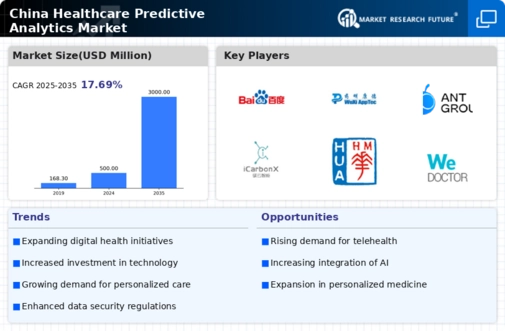Growing Focus on Preventive Healthcare
The healthcare predictive-analytics market is experiencing growth due to a heightened focus on preventive healthcare in China. As the population ages and chronic diseases become more prevalent, there is an increasing emphasis on early detection and intervention. Predictive analytics tools are being utilized to identify at-risk populations and develop targeted prevention strategies. This trend is supported by government initiatives aimed at promoting preventive healthcare measures. By 2025, it is anticipated that the market for predictive analytics in preventive healthcare will account for nearly 30% of the overall healthcare predictive-analytics market, reflecting a shift towards proactive health management.
Advancements in Technology Infrastructure
Technological advancements in data storage, processing, and analytics capabilities are significantly impacting the healthcare predictive-analytics market. In China, the proliferation of cloud computing and big data technologies has facilitated the collection and analysis of vast amounts of healthcare data. This infrastructure enables healthcare organizations to implement predictive analytics solutions more effectively. As of 2025, it is estimated that over 60% of healthcare institutions in China will adopt cloud-based analytics platforms. This shift not only enhances data accessibility but also allows for real-time analytics, which is crucial for timely decision-making in patient care and resource management.
Integration of Wearable Health Technologies
The integration of wearable health technologies is emerging as a key driver for the healthcare predictive-analytics market. In China, the adoption of wearable devices, such as fitness trackers and smartwatches, is on the rise, providing a wealth of real-time health data. This data can be analyzed to predict health trends and outcomes, enabling healthcare providers to offer personalized care. As of November 2025, it is estimated that the number of wearable device users in China will exceed 200 million, creating a substantial data pool for predictive analytics. This trend not only enhances patient engagement but also supports the development of tailored health interventions.
Rising Demand for Data-Driven Decision Making
The increasing complexity of healthcare systems in China has led to a rising demand for data-driven decision making within the healthcare predictive-analytics market. Healthcare providers are increasingly recognizing the value of utilizing data analytics to enhance patient outcomes and operational efficiency. According to recent estimates, the market is projected to grow at a CAGR of approximately 25% over the next five years. This growth is driven by the need for improved patient care, cost reduction, and the optimization of resources. As healthcare organizations seek to leverage data for strategic planning, the healthcare predictive-analytics market is likely to see a surge in investment and innovation, enabling providers to make informed decisions based on predictive insights.
Increased Investment in Healthcare IT Solutions
Investment in healthcare IT solutions is a significant driver of the healthcare predictive-analytics market. In China, both public and private sectors are channeling substantial funds into healthcare technology to improve service delivery and patient outcomes. The government has initiated various funding programs aimed at enhancing healthcare infrastructure, which includes investments in predictive analytics tools. By 2025, it is projected that healthcare IT spending in China will reach approximately $50 billion, with a considerable portion allocated to predictive analytics solutions. This influx of capital is likely to accelerate innovation and adoption of advanced analytics capabilities across healthcare organizations.


















Leave a Comment